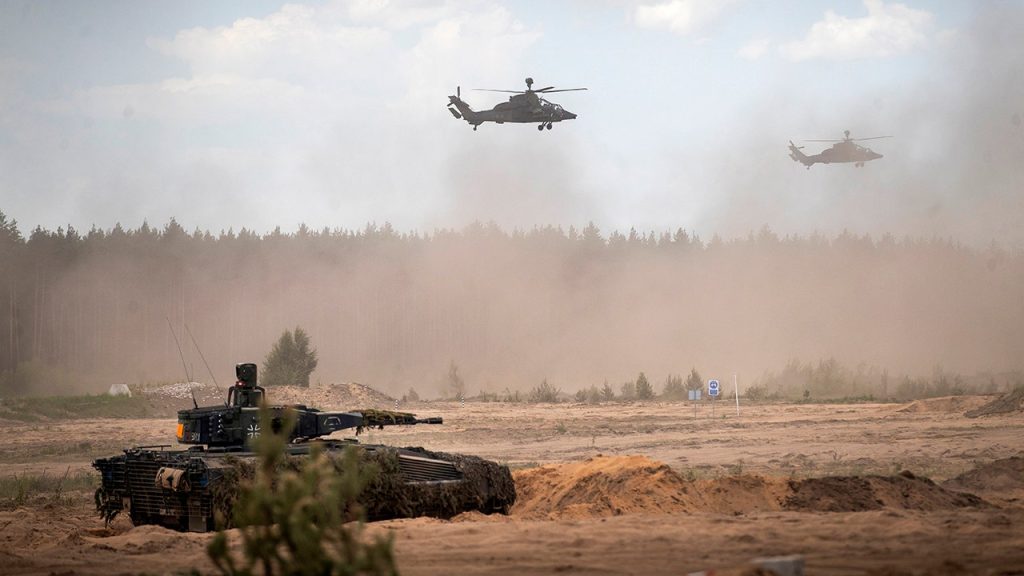The search efforts for four U.S. Army soldiers who went missing during a training exercise in Lithuania are ongoing, following the discovery of their sunken military vehicle. As NATO officials clarified that the fate of the soldiers is still uncertain, various military and civilian agencies are engaged in extensive recovery operations. The incident has raised concerns about the circumstances surrounding the disappearance of the soldiers from the 1st Brigade, 3rd Infantry Division, stationed at Fort Stewart in Georgia.
| Article Subheadings |
|---|
| 1) Overview of the Incident |
| 2) Search and Recovery Operations |
| 3) Reactions from Military Officials |
| 4) Context of U.S. Military Exercises in Lithuania |
| 5) Implications for U.S.-Lithuania Relations |
Overview of the Incident
On a typical training day, four soldiers from the U.S. Army’s 1st Brigade, 3rd Infantry Division, stationed at Fort Stewart in Georgia, encountered a tragic incident during a scheduled tactical exercise near Pabradė, Lithuania. Reports indicate that they went missing after an accident involving their M88 Hercules armored recovery vehicle. This occurred in a training area where soldiers were conducting exercises to enhance their tactical skills. The incident is being treated with utmost seriousness as search operations commenced immediately after the soldiers were reported missing.
Search and Recovery Operations
Coalition forces, including U.S. Army personnel and Lithuanian Armed Forces, have mobilized resources for a coordinated search and recovery operation. The search has expanded into bodies of water where the missing vehicle was later located, signifying a complex recovery challenge. Despite the current focus on the missing soldiers, NATO officials have underscored that their condition remains unverified, and search efforts are marked by both urgency and delicacy. The role of local authorities and civilians highlights the comprehensive nature of this operation, where multidisciplinary teams strive to ensure the best possible outcome. Lt. Gen. Charles Costanza, commanding general of V Corps, acknowledged the quick response from Lithuanian forces and emphasized teamwork in these strenuous conditions.
Reactions from Military Officials
Military leaders have expressed their condolences and support for the families of the missing soldiers. “This is really terrible news and our thoughts are with the families and loved ones,” stated NATO Secretary General Mark Rutte in a press briefing. The 3rd Infantry Division has also been keeping families informed of updates regarding the ongoing search. In a message shared via social media, division officials expressed their thoughts and prayers for the missing soldiers, highlighting their commitment to transparency during this challenging period. As the search evolves, leaders across various branches of the military remain vigilant in their communications with families and the media.
Context of U.S. Military Exercises in Lithuania
The presence of U.S. troops in Lithuania is part of a broader NATO initiative designed to bolster defense and deterrence capabilities in Eastern Europe amid heightened tensions with Russia. Lithuania’s strategic location—less than 6 miles from the border with Belarus, a close ally of Russia—adds gravity to these military exercises. This incident underscores the serious nature of overseas military training, which often involves challenging terrain and complex operational dynamics. Understanding these contexts is crucial for interpreting the implications of such incidents and their effect on international military cooperation.
Implications for U.S.-Lithuania Relations
In the aftermath of the incident, U.S.-Lithuania relationships may face scrutiny as stakeholders assess military protocols during training exercises. Lithuania’s relationship with the U.S. has been strengthened since joining NATO in 2004 and is further reinforced by shared concerns about regional security threats, particularly from Russia. However, incidents like this may prompt reassessment of safety measures in military operations. Officials are likely to focus on internal investigations to ensure improvements in training safety and prevent future tragedies.
| No. | Key Points |
|---|---|
| 1 | Search efforts for the missing soldiers are ongoing and being conducted by U.S. Army and Lithuanian authorities. |
| 2 | The U.S. Army has confirmed that the four soldiers went missing during a tactical training exercise in Lithuania. |
| 3 | NATO officials clarified that the fate of the soldiers remains unknown as search operations continue. |
| 4 | Lithuania’s geographical proximity to Russia raises concerns over military safety and operational protocols. |
| 5 | Military leaders have expressed condolences and emphasized the importance of teamwork in recovery efforts. |
Summary
The ongoing search for the four missing U.S. Army soldiers in Lithuania serves as a somber reminder of the inherent risks associated with military training exercises, particularly in regions with strategic military significance. As NATO and U.S. military officials work collaboratively to locate the soldiers, the emphasis remains on community, support, and transparency. The situation calls for a broader conversation around safety standards in military operations abroad, particularly in contexts marked by geopolitical tension.
Frequently Asked Questions
Question: What happened to the missing soldiers during their training exercise?
The missing soldiers from the U.S. Army were involved in a training accident while conducting tactical exercises in Lithuania, leading to concerns about their safety following the discovery of their sunken military vehicle.
Question: What steps are being taken to locate the missing soldiers?
Search and recovery operations are being coordinated by the U.S. Army, Lithuanian Armed Forces, and civilian agencies, with extensive resources devoted to locating and assessing the situation regarding the missing soldiers.
Question: Why are U.S. troops training in Lithuania?
U.S. troops are conducting training exercises in Lithuania as part of NATO initiatives aimed at enhancing defense cooperation and addressing regional security threats, especially given the proximity to Russia.


